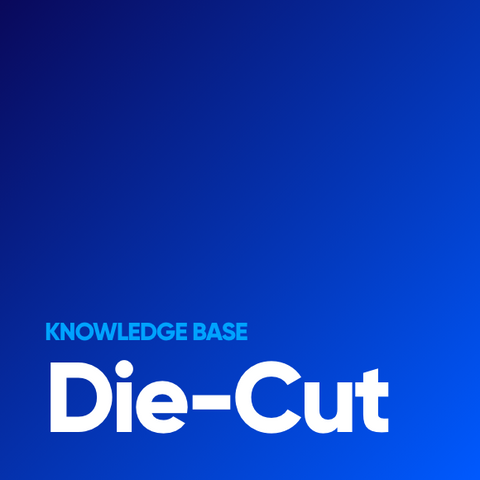Die-Cut: Shaping Paper Creatively
In the world of design and print, there's a craft that often goes unnoticed but profoundly impacts how we perceive printed materials—Die-Cut. It's the art of cutting paper or other materials into unique and intricate shapes, transforming flat surfaces into three-dimensional works of art. Beyond its role in the world of print, Die-Cut offers a window into the marriage of creativity and precision, where imagination takes form. In this exploration, we'll dive into the world of Die-Cut, revealing its importance, understanding its applications, and appreciating the craftsmanship behind this subtle yet significant art.
The Essence of Die-Cut
At its core, Die-Cut is the process of cutting paper or materials into specific shapes using a die—a specialized tool or mold. The essence of Die-Cut lies in its ability to transcend the limitations of flat, two-dimensional paper and transform it into a three-dimensional marvel. This process enables a wide range of shapes and designs, allowing for creativity to flourish.
Significance of Die-Cut
Die-Cut is significant for several reasons:
-
Visual Appeal: Die-cut adds visual intrigue and depth to printed materials, making them stand out and capture attention.
-
Uniqueness: It allows for the creating of unique, custom shapes that are impossible to achieve with standard cutting methods.
-
Engagement: Die-Cut designs engage the sense of touch and encourage interaction with printed materials.
-
Brand Representation: It helps in representing a brand's identity, conveying creativity and attention to detail.
-
Enhanced Communication: Die-Cut can communicate messages effectively, with shapes and designs that reinforce the content's theme.
The Craft of Die-Cut
The art of Die-Cut involves several key elements:
-
Die: This is the specialized tool or mold used to cut the material into a specific shape. Dies can be custom-made to match unique designs.
-
Material: Die-cut is not limited to paper; it can be applied to various materials, including cardboard, plastic, fabric, and more.
-
Precision: Precision in the cutting process is essential to ensure the final product matches the intended design.
-
Customization: Die-Cut offers endless possibilities for customization. Designers can experiment with shapes, sizes, and patterns.
Applications of Die-Cut
Die-cut is a versatile technique that finds applications across various fields:
-
Print Marketing: Die-cut is used in brochures, business cards, and promotional materials to make them visually striking.
-
Packaging: Die-cut packaging protects the contents and adds a touch of elegance and creativity to the product presentation.
-
Greeting Cards: The world of greeting cards benefits greatly from Die-Cut, allowing for intricate designs and pop-up elements.
-
Labels and Stickers: Brands use Die-Cut labels and stickers to ensure their products stand out on the shelves.
-
Books and Publications: Die-Cut can be applied to book covers and pages to enhance the reading experience.
Creating Effective Die-Cut Designs
To create effective Die-Cut designs, consider these strategies:
-
Design with Purpose: Every Die-Cut should serve a purpose to enhance the visual appeal or communicate a message.
-
Material Selection: Choose the suitable material for your Die-Cut design, considering its properties and how it complements the design.
-
Precision in Execution: Precision is crucial in Die-Cut, so work with experienced professionals who can deliver the desired result.
-
Consistency: Maintain consistency in Die-Cut designs to reinforce brand identity and recognition.
-
Interactive Design: Explore the interactive potential of Die-Cut. Designs that encourage touch and engagement can leave a lasting impression.
Impact and Significance of Die-Cut
The impact of Die-Cut is multi-faceted:
-
Visual Intrigue: Die-cut designs capture attention and curiosity, making printed materials visually appealing.
-
Uniqueness: Custom Die-Cut shapes set products and materials apart, conveying creativity and individuality.
-
Tactile Experience: Die-Cut engages the sense of touch, enhancing the overall experience and memorability.
-
Brand Identity: It contributes to brand identity by representing a commitment to detail and creativity.
-
Effective Communication: Die-Cut can enhance the communication of messages by aligning shapes and designs with the content's theme.
Die-Cut in Diverse Industries
Die-Cut is pervasive in various industries:
-
Fashion: Clothing tags and packaging often feature Die-Cut designs that enhance the brand's image.
-
Food and Beverage: Labels on food and beverage packaging use Die-Cut for unique shapes and designs.
-
Entertainment: Movie promotions and music album packaging utilize Die-Cut to create visually appealing and engaging materials.
-
Arts and Crafts: Die-cut machines have made it accessible for artists and crafters to experiment with intricate designs.
-
Event Marketing: Invitations, banners, and event promotional materials benefit from Die-Cut for visual appeal.
The Future of Die-Cut
As the world of design and printing continues to evolve, the future of Die-Cut holds exciting possibilities:
-
Digital Integration: Digital technologies are increasingly used to achieve precision in Die-Cut designs, opening up new avenues for creativity.
-
Sustainability: Sustainable Die-Cut practices will gain importance, with eco-friendly materials and waste reduction being prioritized.
-
Personalization: Die-Cut may become more personalized, allowing for unique designs tailored to individual preferences.
The Craft of Shaping Creativity
Die-Cut is not merely a cutting technique; it's a craft that shapes creativity and transforms materials into visually intriguing works of art. It goes beyond flat surfaces, adding depth, uniqueness, and engagement to printed materials. Die-Cut designs leave a tactile and visual impact, capturing attention and conveying brand identity. In the ever-evolving world of design and print, Die-Cut stands as the subtle yet significant art that brings creativity to life, one intricate shape at a time.

Die-Cut





